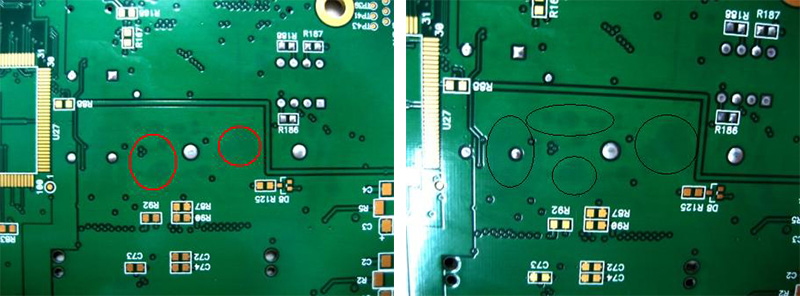What is the problem of discolouration of plating in baking after cutting for PCB manufacturing? Why is there a problem of discolouration of the plated layer after cutting and baking? What should I do to solve the problem of discoloured plating after cutting and baking?
Plating discolouration can be caused by chemical reactions or physical changes due to external conditions or material properties. For different types of plating or coatings, discolouration can mean different problems, for example, for plating on metal surfaces, discolouration can mean corrosion or a chemical reaction, whereas on painted surfaces it can mean a loss of gloss or a quality problem with the coating.
For plating discolouration problems, a detailed analysis and investigation of the coating material, the treatment process and the environmental factors may be required to determine the causes of the discolouration and to take appropriate measures to solve or avoid these problems.
What is “Plating Discolouration”?
“Plating discolouration” is the phenomenon whereby a surface plating or coating changes colour under certain conditions. Such changes can include a noticeable change in colour, a darkening or brightening of the hue, the appearance of spots or stains, and so on.

PCB Manufacturing After Cutting And Baking Plating Discolouration Will Lead to What?
1、Quality problems: plating discolouration may mean that the quality of the coating or surface treatment problems, which may lead to the product in the quality inspection was found to be unqualified, which in turn affects the product’s reputation for quality.
2、Functional impact: discolouration of the coating may indicate that the coating has undergone a chemical change or component changes, which may affect the functional properties of the coating, such as corrosion resistance, abrasion resistance, heat resistance and so on.
3、Appearance problems: discolouration of the coating will lead to poor product appearance, the loss of the original aesthetics and texture. This may affect the sales appeal of the product or the appearance of quality requirements.
4、Customer satisfaction: Discoloured coatings may not meet customer expectations, reducing customer satisfaction and trust in the product, which may affect future sales and customer relations.
5、May lead to rejection: If the product discolouration is deemed to be outside of the required acceptance criteria or quality standards, it may lead to rejection of the product by the customer or the quality control department.
Why is There a Problem of Discolouration of The Plating?
1、High temperature caused by oxidation: high temperature environment, especially in the baking process, may lead to certain elements or compounds in the coating oxidation reaction, resulting in colour change. This may be caused by oxygen into the baking equipment or improper baking conditions.
2、Chemical reaction: the baking process may exist with the coating material interaction of chemical substances or gases, these substances may react with the components in the coating, resulting in a change of colour.
3、Poor material heat resistance: the coating material itself may not be resistant to high temperatures, when exposed to high temperatures, the nature of the coating may change, resulting in colour changes.
4、Improper baking conditions: Incorrect conditions such as temperature, time and humidity during the baking process may lead to uneven heating of the coating, with part of the area being too hot or too cold, resulting in a change in the colour of the coating.
5、Inappropriate atmosphere control: baking process there may be inappropriate atmosphere or air flow, for example, the presence of excessive oxygen or other gases, may affect the stability and colour of the coating.
Solution
1、Adjust the baking parameters: reevaluate the baking temperature, time and environmental conditions. Ensure that the temperature is controlled within the range that the coating can withstand, and avoid excessive temperatures and long baking times.
2、Optimise the baking process: Adjust the environmental conditions during the baking process, such as ventilation, humidity, etc., to ensure that it is carried out under stable baking conditions and avoid unnecessary chemical reactions or oxidation.
3、Adopt high temperature resistant coating material: If the coating material is not high temperature resistant, consider replacing the high temperature resistant coating material to ensure that no colour change occurs during the baking process.
4、Control the atmosphere and chemical substances: During the baking process, control the atmosphere and avoid exposing the coating to gases or chemical substances that may cause chemical reactions.
5、Testing and verification: Conduct small-scale experiments to adjust different parameters, and observe and evaluate the coating before and after baking. Find out the most suitable baking parameters and process through experiments.
6、Professional Consultation: If the problem still exists, it is best to consult coating experts or suppliers for their advice and guidance. Professionals can provide targeted solutions and may conduct more in-depth testing and analysis.
Solving the problem of plating discolouration after baking after cutting for PCB manufacturing may require a combination of practical situations and professional advice, and may require a number of tests and adjustments to find the best solution.


